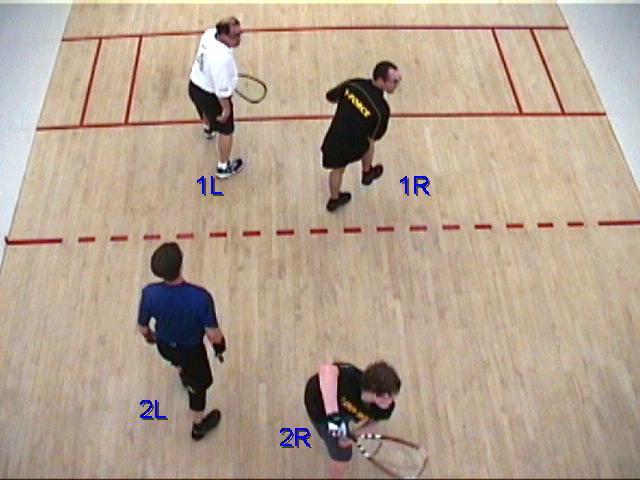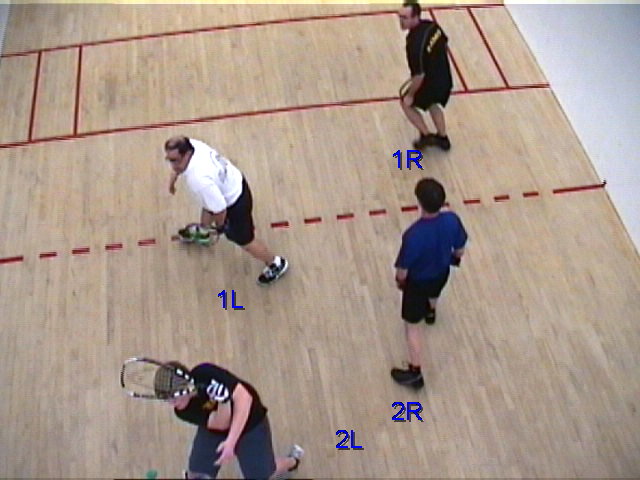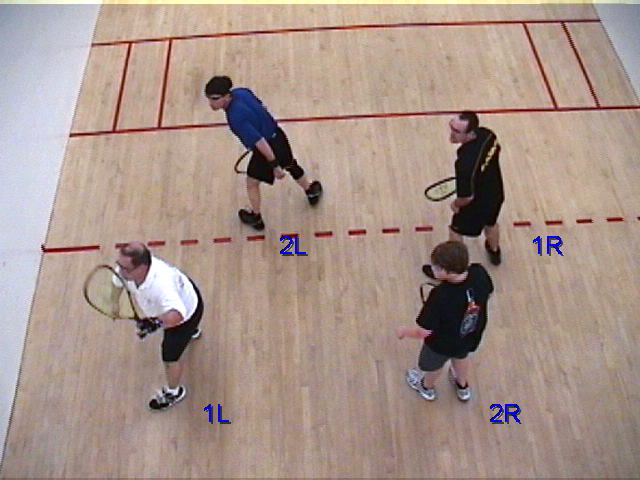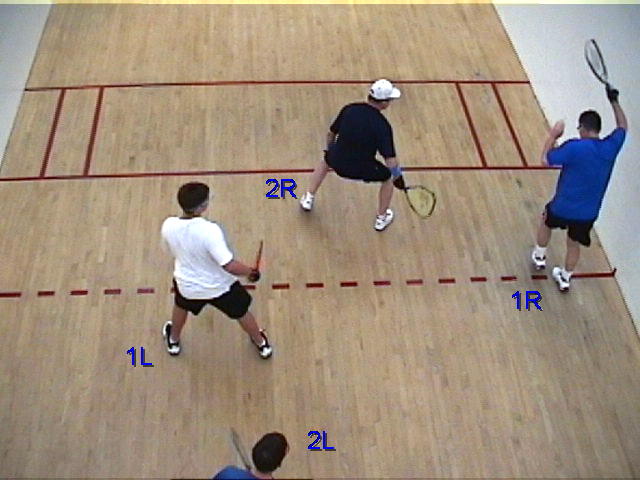
Doubles is a great game. It is racquetball, but it is different from singles. A lot of players prefer it because it takes more thinking and strategy to score against two opponents. Other players prefer it because it is less physically demanding. However, it requires quick reflexes because much of the play is closer to the front wall. It is the game to play if you have lots of players and few courts. Finally, it is a more social game, which makes it a lot of fun.
Doubles is all about court positioning. The most common formation is side-by-side. For the usual righty-righty team, the player with the best backhand plays the left side and is the "quarterback." He or she is responsible for the left two-thirds of the court and takes both the backhand shots on the left side wall and the forehand shots in the center of the court. The quarterback also directs the other player by giving verbal commands. The right side player is responsible for the right one-third of the court, hits mostly forehands, and does what the quarterback says. The right side player never hits a backhand in the center third of the court except when the left side player is out of position and can't take the forehand or when the quarterback says to hit it.
Because there are two players,each one has backup, so both players can play further forward than in a singles game.The center of the court is the dotted line. (The center of the court for the singles game is 2-3 feet behind the dotted line.) Just as in singles, dominating the center of the court is the key to winning a doubles game.
If your team is serving, after you serve, you and your partner must try to relocate immediately to the dotted line in a side-by-side position. The server backs up into position. The non-server takes a couple of diagonal steps away from the side wall. In this position, the left side player can cover the left 2/3 of the court with a single cross-over step. The right side player can cover anything down the line with a cross-over step and cover the center of the court with the backhand in an emergency. Since you are both on, or close to, the dotted line, only a perfect pinch or kill shot will win the point outright, both of which are low percentage shots.
If you drive serve, you will not have time to get to the dotted line before your opponent returns the serve. This means that your team will be vulnerable to a good passing shot. If your team is receiving serve, one you will return the serve, the other should move to center court around the dotted line. Remember to keep your eye on the ball, even when it is behind you, because you might have to get out of the way. In Figure 1 below, the left side player (1L) has just served. Both players are watching the ball while relocating toward the dotted line. Note that the right side player (1R) has given his opponent (2R) both a straight-in and cross-court shot.
Figure 1
Once the rally begins, assuming you are on defense, you must try to reduce the number of opportunities for your opponent. If you are on defense, be sure to get in front of your opponent. You can't return a shot you can't see.
Let's assume the ball is in the right side back corner, as in Figure 1. The right side player (1R) should be located toward the middle of the court, to cover any passing shots (and to give the opponent a straight-in and cross-court shot). The left side defensive player (1L) should be a step or two up toward the short line to cover the pinch.
If the ball is in the back left corner, the left side defender is back in center court while the right side defender is up to cover the pinch. If the ball is in the middle of the back court, both defensive players must move to the side to avoid a hinder. If you are on offense, and the ball is your responsibility, you have to go wherever the ball is (2R in Figure 1).
If you are the non-shooter, you should be in center court, near the dotted line, ready to return a cut-off shot. (2L is moving up to the dotted line in Figure 1.) Be sure to keep out of the way so that you do not hinder your opponents. Take a step back and let them get in front of you.
After your team shoots, if the ball is in front of the dotted line, you must take a step back so as to give your opponent an opportunity to play the ball. If the ball is in the back court, you must give your opponent both a straight-in and cross-court shot, so get out of the way.
In Figure 2 below, player 2L is shooting. The defending left side player (1L) is back and toward center court, giving the shooter both a straight-in and cross-court shot. However, he is still in position to defend a down the line shot. The defending right side player (1R) has moved up to cover the pinch.
Figure 2

In contrast, look at Figure 3 below. The ball is in the left back corner. Player 1L is the shooter. Player 2L is in center court ready to defend a down the line shot. The non-shooter (1R) is in good center court position near the dotted line. However, the defending right side player (2R) is too far back, leaving the pinch uncovered. Note, however, that everyone has his eye on the ball.
Figure 3

A player on the wall has only one side and can be easily jammed. Such a player also takes away his partner's cross-court or wide angle pass by hindering the opponent. In Figures 4 and 5 below, player 1R is too close to the wall and barely avoids being hit by his partner's wide angle pass. If you are playing a team with someone who stays close to the side wall, hit to that side, right at the player on the wall, as often as possible. Also, if your opponent has a player that is slow to leave the doubles box when his or her partner is serving, try to return all serves as wide angle passes aimed to hit the side wall right at the doubles box where he or she will be jammed.
Figures 4, 5


Another formation that is frequently employed is the "I" formation, also known as the "up and back", or "front and back." In this formation, one player plays the front court from around the dotted line, while the other player stays in the back court. I don't recommend this formation because it leaves the sides undefended.
The last formation that is frequently employed is the "staggered up and back," where one player is up and to the right while the other is back and to the left (or vice-versa). This formation is just a special case of the side-by-side, if the side-by-side players move up and back depending on which member of the opponent team is shooting. I recommend the side-by-side formation, with players moving up and back depending on the shooter because it does a better job of defending the sides and the pinch.
Teams with one left handed and one right handed player have an obvious advantage, namely, you are serving to two forehands and all shots to the corners will be returned by a forehand. However, hitting the ball down the middle might sow some confusion. For example, in Figure 6 below, the Number 1 team is on offense, the ball is coming off the back wall into the middle of the court. The left side player (1L) has decided to let the right side player (1R) have the shot. Apparently this comes as a surprise to the right side player, who has to dive to make the shot.
Figure 6

If you are on a lefty-righty team, be sure to designate the default backhand hitter (quarterback) who will take all the backhand shots unless something is terribly wrong. Be sure to communicate by saying "Mine" or "Yours," just to make sure.
All the usual etiquette rules of singles apply to doubles. However, because there are four players in a confined space with a ball traveling over 100 mph, it is important to play safely. Always hold up if there is a chance that your shot will hit someone. Never object to someone else's safety hold-up. Expect a lot of hinders. Don't object to hinder calls by your opponents. If there is a referee, try to help. It is much more difficult to ref a doubles match than a singles match. Don't take advantage of mistakes by the referee. Overturn any incorrect calls that go your way.
Treat your partner with courtesy and respect. Avoid negative criticism. Avoid eye-rolling, shoulder-slumping, head-slapping or other negative body language. Be upbeat and positive. If things are not going well, take a time out and talk about it. If you have to carry your partner today, he or she may have to do the same for you tomorrow. Much of the same advice in more abbreviated (and perhaps more memorable) form is available here.